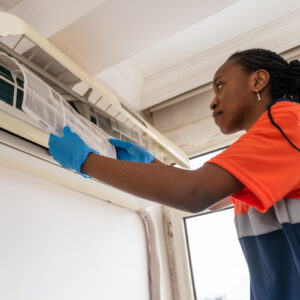Window installation may seem straightforward, but it’s a project that requires precision, skill, and attention to detail. A well-installed window can enhance your home’s energy efficiency, improve curb appeal, and provide lasting protection against the elements. However, even the smallest installation error can lead to air leaks, water infiltration, and operational issues can turn a simple upgrade into a costly problem.
Below, we’ll take a closer look at the most frequent window installation errors and the right practices to achieve perfect, long-lasting results.
Most Common Window Installation Mistakes
1. Ignoring Accurate Measurements
Inaccurate measurements before the actual installation is one of the most frequent and expensive errors in the installation of windows. Failure of a window to fit perfectly in the opening can result in gaps, drafts and insulation. Even a window that is slightly oversized can need forced fitting to fit, which can ruin the frame, and a too small window might result in awkward spacing that will interfere with the process of sealing and stability.
It is essential to be able to make sure that measurements are accurate. All window opening ought to be measured numerous times in width and height, up to the bottom and on either side. Fitment may be influenced by even the smallest anomaly on the wall or frame, thus accuracy at this point precondition a flawless installation.
2. Skipping Proper Sealing
The performance of a window is greatly determined by the seal of the window. However, the most common causes of post-installation issues include air leaks, moisture intrusion and drafts and in this case, improper or incomplete sealing is considered to be the causes. Through improper application of sealants or use of inferior materials, the spaces between the frame may leak resulting in loss of energy and subsequent destruction of water in the long run.
Installation of a well-installed window should be completely insulated in all corners. The high quality caulking and weatherproof flashing will also make the window water tight and energy-saving without the problems such as condensation and rot.
3. Neglecting Level and Alignment
A perfectly shaped and closed window may not work when it is not level and aligned. Even when windows are fitted even a bit out of the square, they do not always open, close, and lock. In time, this mismatch may cause the hardware to overload and push the integrity of the frame.
It is important to make sure that the window is fixed in a level, plumb, and square manner. This is a process that is delicate and delicate since a minor change can yield a huge difference. Not only will a properly aligned window appear more professional, but it is also going to be easy to use and last longer.
4. Forgetting Moisture Barriers
One of the largest threats to any structure is moisture and windows are some of the key areas through which water can penetrate. When installation of proper moisture barriers or flashing are not taken care of during window installation, one of the possible outcomes is the development of water behind the frame which leads to covert destruction of walls, insulation and interior finishes.
A good moisture barrier system will help divert water off the window opening to keep your home dry, free of leakages, molds and rot. This is required more so in regions that are subject to extreme weather conditions such as heavy rain or weather variations.
5. Using Incorrect Fasteners
Each installation of windows needs special fasteners, depending on the kind of material and construction. The wrong screws, nails or anchors may lead to instability, warping or even cracks of the frames. There is a possibility of corrosion of some fasteners resulting in loosening or structural failure with time.
The use of fasteners, as recommended by the manufacturer, prevents damage to the frame as a result of attaching it. Long lasting performance is best achieved by using corrosion-resistant or galvanized fasteners.
6. Overlooking Insulation Around the Frame
The insulation is important to provide a comfortable atmosphere in the indoor environment, but most of the installations do not cover the gap between the window frame and the wall opening. Unoccupied spaces may cause drafts and temperature variations as well as increased energy bills. This error is frequently not noticed until when the houseowner feels uncomfortable or he or she notices an increase in utility bills.
Reinforcing such cavities with low expanding foam or any other special materials which do not exert pressure on the frame and do not allow air infiltration is a proper way of insulation. Insulation does not only help in saving on energy, but also in soundproofing and comfort in the home.
7. Ignoring Building Codes and Manufacturer Guidelines
The building codes of every region provide certain guidelines concerning the installation of the windows, namely safety glass, egress sizes and energy efficiency levels. The repercussions of not observing such codes or keeping the guidelines of the manufacturer can be fines and warranty indemnities. Window Installation Contractors near Baltimore, MD must always comply with the specifications of the manufacturer as well as local regulations.
8. Overlooking the Importance of Exterior Finishing
Once the window is in place, the job isn’t done. Neglecting the finishing touches — such as trim work, exterior cladding, and sealing joints can compromise both aesthetics and function. Poor finishing allows water to penetrate behind the siding, which can lead to damage and reduce the window’s lifespan. Proper exterior finishing gives the installation a polished look while providing another layer of protection against moisture and air infiltration.
Conclusion
Installing new windows is a smart investment in your home’s comfort, energy efficiency, and value but only if the installation is done correctly. From precise measurements and proper sealing to correct alignment and insulation, every detail plays a role in achieving the best results. Avoiding these common window installation mistakes ensures your windows look great, function properly, and perform efficiently for years to come.




